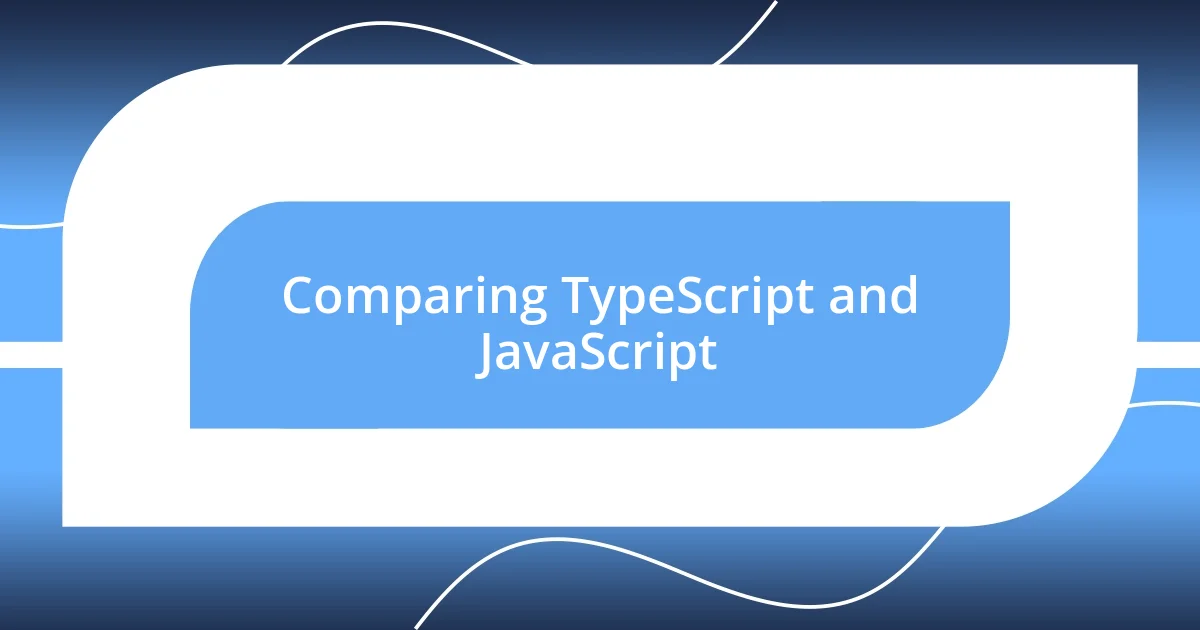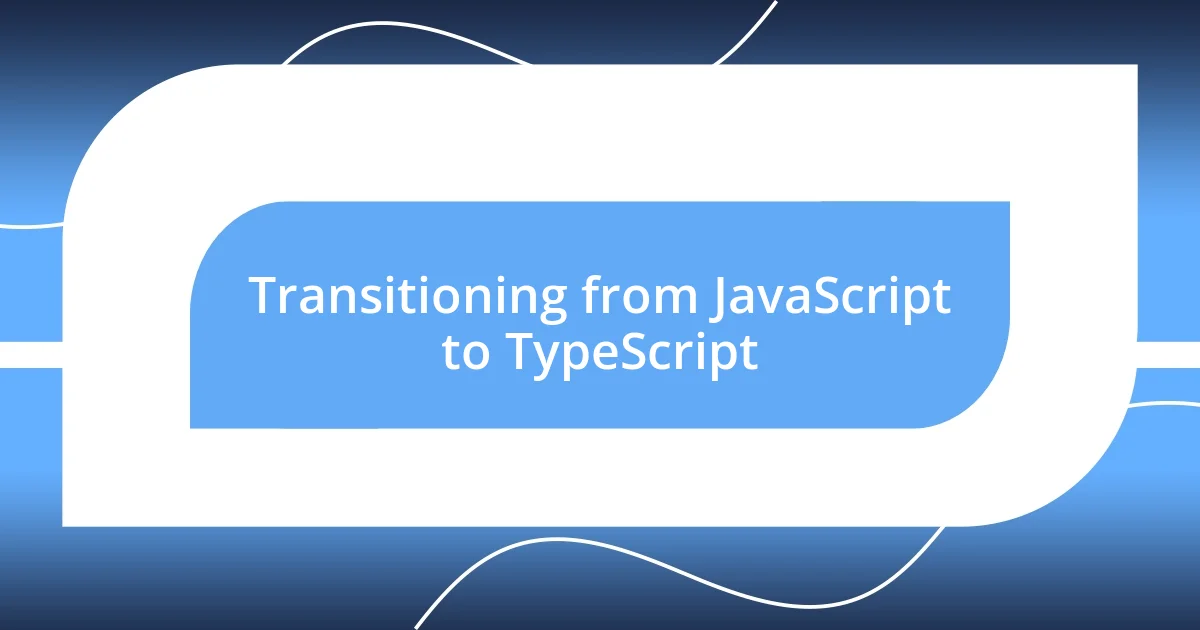Key takeaways:
- TypeScript’s static typing and clear type definitions significantly reduce runtime errors and enhance collaboration among developers, leading to a more efficient coding experience.
- The transition from JavaScript to TypeScript improves code quality through type safety, better readability, and easier refactoring, allowing developers to focus on feature development without constant debugging.
- TypeScript’s growing community and wealth of resources provide strong support for developers, fostering a collaborative environment and encouraging contributions to its ongoing evolution.

Understanding TypeScript benefits
One of the standout benefits of TypeScript is its static typing feature. When I first started using it, I felt a sense of relief knowing that potential errors could be caught at compile time rather than waiting for them to appear during runtime. Can you imagine the level of stress that lifts off your shoulders when you can catch those pesky bugs early on?
Another aspect I absolutely love about TypeScript is its intuitive interface with modern frameworks like Angular or React. I vividly remember tackling a complex project that required a lot of component interactions. TypeScript’s rich tooling and autocompletion made it easier for me to grasp what props I needed, ultimately streamlining my workflow and boosting my productivity. Isn’t it great when the tools you work with actually make your tasks easier?
Lastly, TypeScript’s ability to enhance collaboration among team members is something I value deeply. In my experience, working on a project with multiple developers can sometimes lead to miscommunication. However, with TypeScript’s clear type definitions, everything feels more structured, leading to fewer misunderstandings. Doesn’t that sound like a game-changer for anyone working in a team environment?

Comparing TypeScript and JavaScript
When I first looked into TypeScript, I was struck by the fundamental differences between it and JavaScript. While JavaScript is dynamic and flexible, which can be freeing, I often found that this flexibility led to unexpected issues down the line. TypeScript offers a more structured approach, giving me a sense of security. It’s like drawing a road map before a long journey—you definitely experience fewer detours.
In terms of tooling, TypeScript shines when compared to JavaScript, especially in large applications. I remember struggling to manage a sizeable codebase written in JavaScript, where types were often unclear and bugs crept in like unwanted guests. Switching to TypeScript, I discovered how its type system and powerful IDE integrations actually clarified many aspects of the code I was working with, leading to quicker debugging and smoother development. What a relief that was!
Furthermore, the community and ecosystem surrounding both languages can’t be ignored. JavaScript has a massive library of resources, but there’s something special about the rising support for TypeScript that feels like it’s fostering a dedicated and passionate community. I recall attending a conference where TypeScript enthusiasts shared their experiences and best practices, and I left feeling inspired to elevate my coding practices. It was illuminating, highlighting how both languages can coexist while TypeScript carves its niche in the development landscape.
| Aspect | TypeScript | JavaScript |
|---|---|---|
| Typing | Static Typing | Dynamic Typing |
| Error Detection | Compile-time Errors | Runtime Errors |
| Community Support | Growing Ecosystem | Mature Ecosystem |

Improving code quality with TypeScript
I’ve really noticed a shift in the overall quality of my code since I started using TypeScript. The inclusion of type checking not only minimizes errors but also gives me a clearer understanding of my data structures and function contracts. I remember staring at a tangled web of JavaScript code, unsure of what type was expected in various places—this uncertainty can be a real roadblock. With TypeScript, I feel more equipped to manage and evolve that complexity because I have concrete types guiding me throughout the process.
Here are a few ways TypeScript has helped me improve code quality:
- Type Safety: By enforcing strict types, TypeScript reduces the likelihood of common mistakes, resulting in more robust code.
- Clearer Intent: When I declare types, it’s like providing a signpost for others (and my future self) about the expected data.
- Refactoring Ease: Changes in code feel less daunting because I can be confident that TypeScript will catch mismatches, allowing me to refactor with reassurance.
- Enhanced Readability: The explicit typing makes the code easier to read, increasing its maintainability for my teammates.
- Better Documentation: Type definitions serve as a form of documentation, reducing the need to hunt through comments or external docs to understand code functionality.
Each time I see the TypeScript compiler flag an issue before it even gets to the browser, I can’t help but feel a sense of accomplishment. It’s like having a smart safety net that catches me before I stumble. The confidence that grows with cleaner code just makes me want to invest even more into mastering this powerful tool.

TypeScript support for large projects
When it comes to large projects, TypeScript truly shines with its organizational capabilities. I recall a project where our team was tasked with building a complex web application with multiple modules and interdependencies. The static type system offered by TypeScript transformed that chaos into manageable segments. Suddenly, I could define interfaces and types, making it easier for everyone on the team to understand how different components interacted without needing to dive deep into the implementation details of each module. Doesn’t that sound like a breath of fresh air?
Another significant advantage I’ve found is TypeScript’s ability to streamline collaboration within larger teams. In one project, having well-defined types meant that when new members joined, they could quickly grasp the codebase without being overwhelmed by ambiguity. It felt like giving them a map right away instead of leaving them to navigate a stormy sea of loosely typed JavaScript. By reducing the onboarding time, we could focus more on feature development and less on miscommunication—who wouldn’t want that?
Moreover, the scalability of TypeScript is a game changer. During a recent endeavor, we had to scale our application to accommodate a surge in users, and TypeScript made that transition much smoother. With the checks and balances provided by the type system, I felt confident making significant changes without the usual fear of breaking existing functionality. Have you experienced that anxiety with JavaScript before? It’s an unshakeable worry that I no longer face with TypeScript as my ally. The ease with which I could adapt our codebase to scale felt liberating, reinforcing my choice to embrace TypeScript for big projects.

Transitioning from JavaScript to TypeScript
Transitioning to TypeScript from JavaScript felt like stepping into a world where clarity reigned supreme. I vividly remember the first time I had to update a function in JavaScript that was riddled with implicit types—the sense of dread was palpable. After adopting TypeScript, those trepidations melted away. The explicit type definitions transformed the way I approached modifications; it was as if suddenly, I had a lifeline guiding me through potential pitfalls.
As I began this transition, I noticed how the common errors that often held me back started to dissipate. I recall an incident where I spent hours tracking down a bug, only to find it stemmed from a simple type mismatch in JavaScript. What a relief it was to find that TypeScript’s compiler would flag such issues early on! I felt empowered, knowing that I could focus more on building features rather than constantly debugging, leading to a more peaceful and productive coding environment.
Moreover, the learning curve wasn’t as steep as I had feared. Engaging with TypeScript’s type system was like learning a new dialect of a language I already knew. Although it required some adjustments in thinking, I discovered that the effort was well worth it. I began to see type annotations not just as extra work, but as essential tools that conveyed my intentions clearly not only to the compiler but also to my future self. Haven’t you ever wished for a clearer path through your coding projects? That’s precisely what I found in TypeScript during this transition.

Community support and resources
One of the standout aspects of choosing TypeScript was the vibrant community support behind it. I distinctly remember joining a TypeScript-focused online forum, and the warmth of the community struck me immediately. It felt like stepping into a welcoming environment where fellow developers readily shared their experiences, tips, and tricks. Have you ever found a community that felt like home? This sense of camaraderie not only made learning TypeScript more enjoyable but also reinforced my decision, knowing I wasn’t navigating this journey alone.
Moreover, I was amazed at the wealth of resources available for TypeScript beginners and veterans alike. I dived into numerous tutorials, documentation, and even video courses that broke down complex concepts into digestible bites. In one instance, I stumbled upon a YouTube series that systematically explained advanced type features. Watching those videos added layers of understanding that I didn’t know I was missing. Isn’t it fulfilling when a resource answers a question you didn’t even think to ask? These readily accessible materials felt like a treasure trove, granting me the confidence to tackle any project with TypeScript.
I also became a fan of how actively TypeScript’s maintainers engage with the community. I recall an update being released that addressed a few pain points I had encountered, and seeing those issues acknowledged made me feel valued as a user. This responsiveness encouraged me to contribute to discussions and even submit a pull request, an experience I hadn’t dared to envision before. How often do you get to be part of a product’s evolution? Being connected to TypeScript’s development has only deepened my appreciation for the language as more than just a tool—it’s a thriving ecosystem.

Real-world applications of TypeScript
I’ve had the opportunity to apply TypeScript in various real-world projects, and the results were impressive. For instance, while working on a large-scale e-commerce platform, I found that TypeScript’s strict typing system significantly reduced the chances of runtime errors, which can be critical in a high-stakes environment like online shopping. Can you imagine the chaos of shoppers facing broken functionalities right before checkout? With TypeScript, we were able to enhance code stability, leading to an improved user experience and fewer support tickets.
In another project, I collaborated with a team to develop a complex dashboard application for data visualization. Here, TypeScript’s interfaces and type definitions played a crucial role in ensuring that our data structures were consistently defined across different components. The moment we encountered a new requirement, I remember feeling confident diving in because of TypeScript’s clarity. Have you ever had a moment where the right tools allowed you to implement changes seamlessly without second-guessing? That’s what TypeScript provided—a solid foundation to innovate without fear.
What truly stood out for me was when we integrated TypeScript with popular frameworks like Angular. The synergy between them allowed for rapid development without sacrificing code quality. I recall the thrill of refactoring a large portion of the codebase, confident that TypeScript’s compiler would catch any potential issues before we pushed our updates. Isn’t it liberating to work in an environment where you can refactor with such assurance? Each project has reinforced my belief in TypeScript’s practical applications, making it not just a preference but an essential part of my development toolkit.












